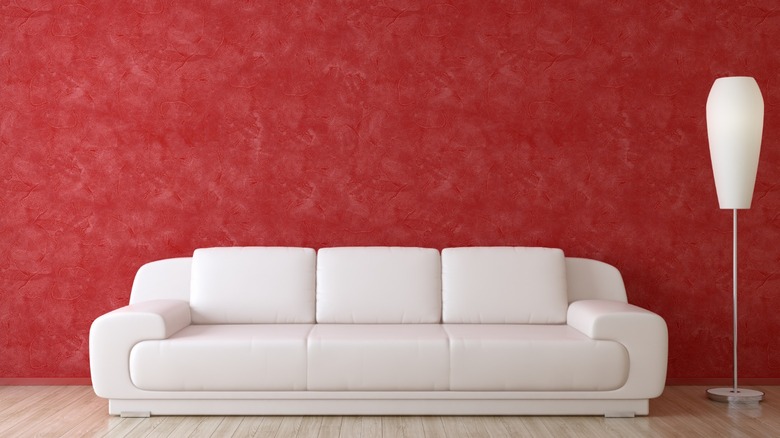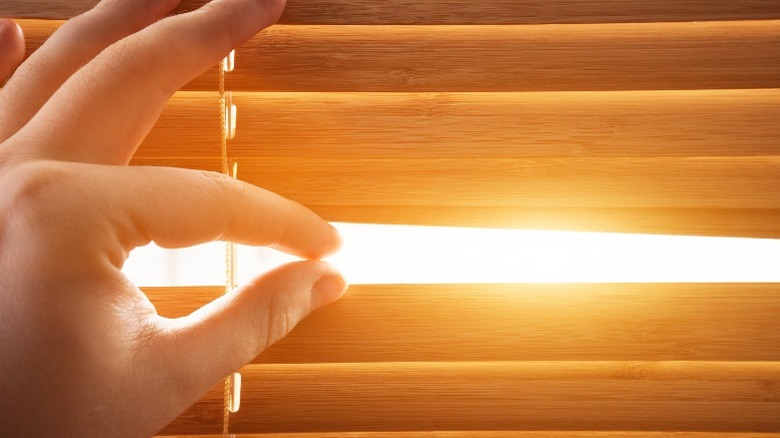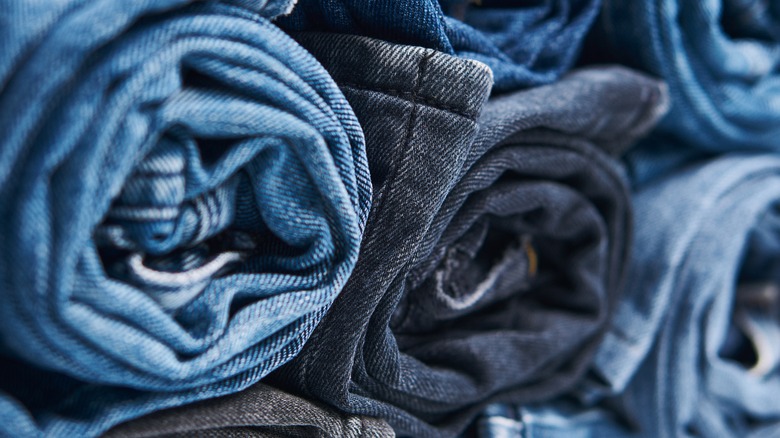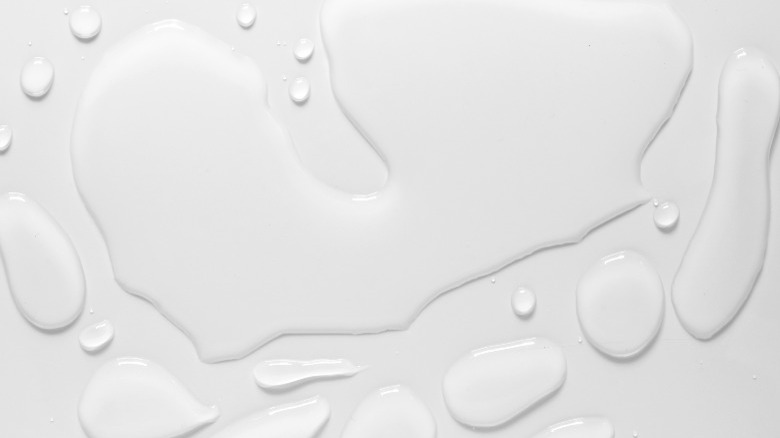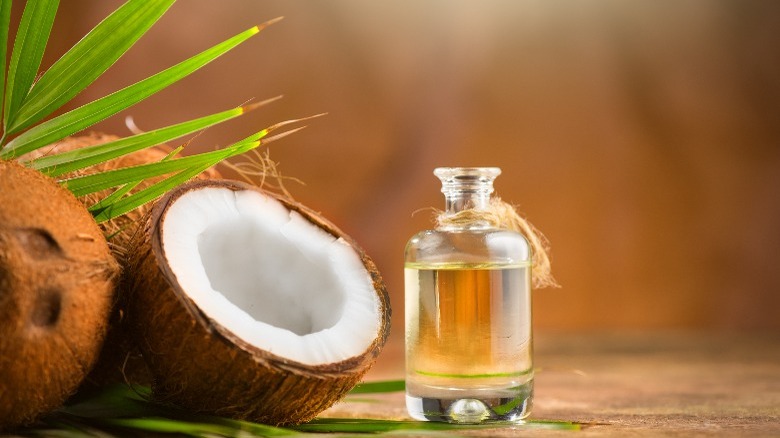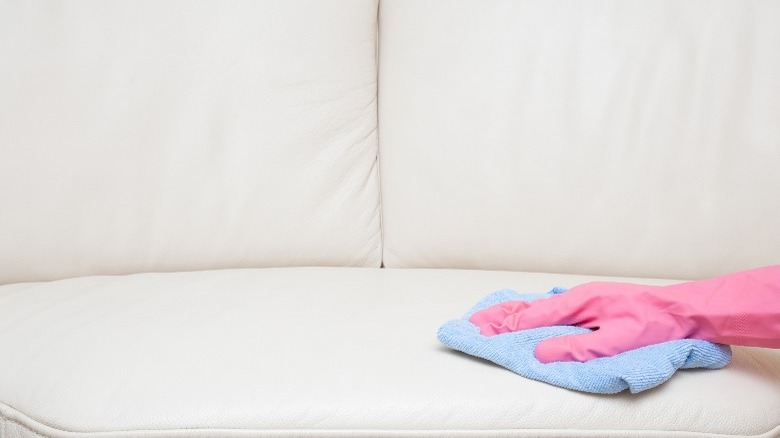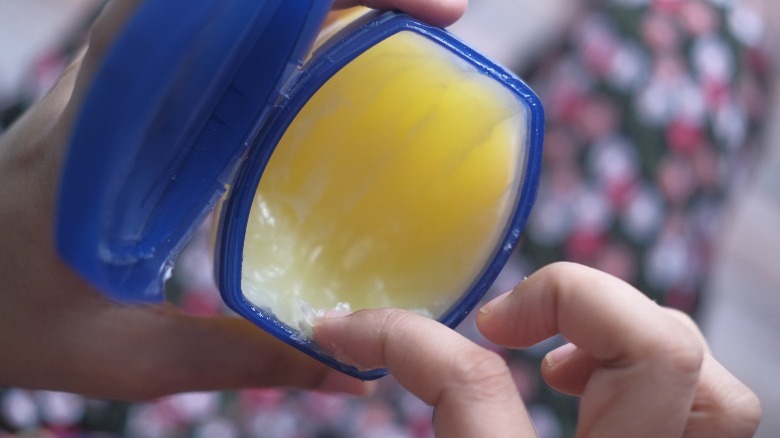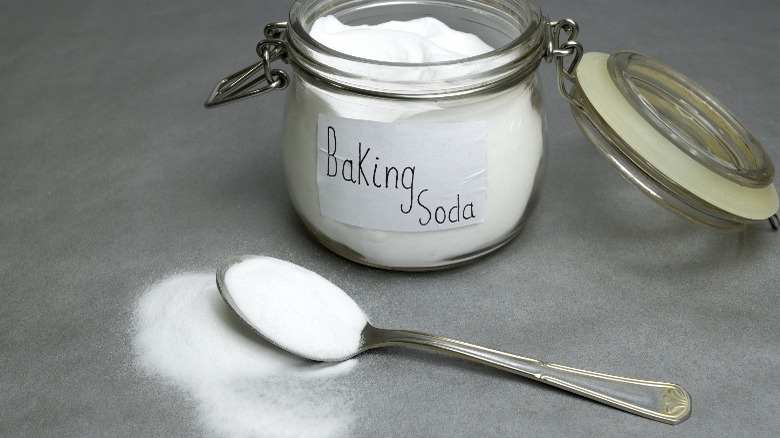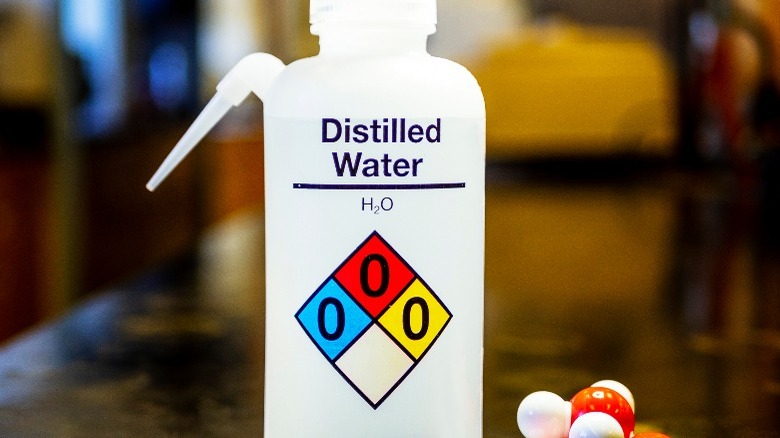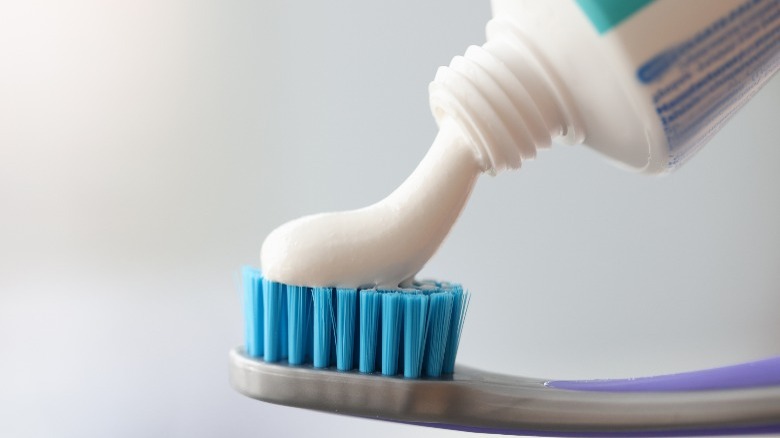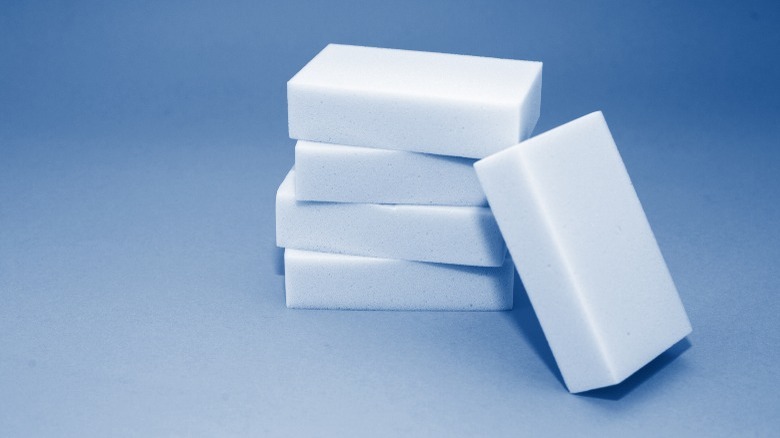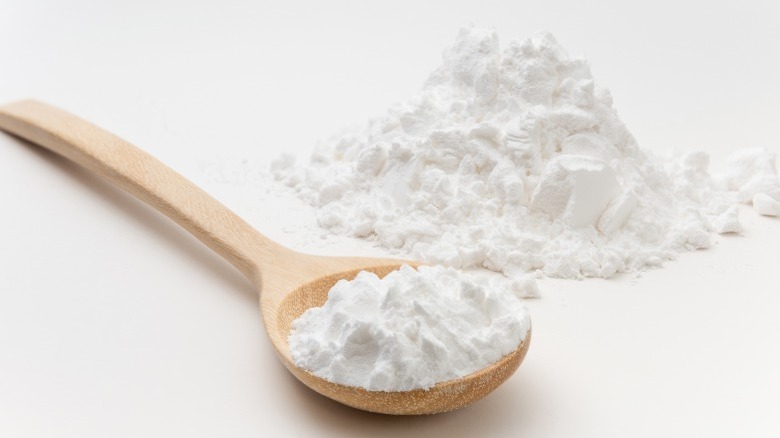How To Keep White Leather In Mint Condition
Leather furniture comes in every color of the rainbow in addition to basic brown and black. But when you hope to make a simple, sophisticated, statement, nothing compares to white leather seating. Budget Friendly Furnishing posts that white furniture can class up a room, and tends to go with almost every decor style. But while leather is known to be a hardwearing material, it can take some stains pretty hard. And when the shade is so light, you can rest assured that every imperfection will stand out like a sore thumb. The risk factor goes up if you have messy humans and pets in your home, of course. Those jelly-covered handprints and black cat hairs detract from the flawless appearance you're aiming for.
Still, you needn't deny yourself the luxury of having a white leather couch. To protect your investment, you'll want to put some thought into where you keep it, care for it, and clean it. White leather couches are easier to care for than you think but require more effort than other kinds of furniture. Guardsman Furniture Professionals points out that leather is easier to maintain than suede and does not absorb odors like other materials.
Aspinal of London agrees that leather upkeep is a bit more involved. Even though dust might not be as obvious on white material, they suggest wiping it down once a week. It's also a good idea to keep sharp things like jewelry away from leather, to prevent rips and scratches. Here are some of the other ways to keep that white leather in mint condition — and preserve its value.
Keep white leather out of the sun
A dazzling white leather couch looks clean and pristine when new, but it can fall victim to oxidation. According to Leather Honey, the natural fibers in the material will naturally change over time. They react with the sun, air, and other elements, which can cause the white color to slowly take on a yellowish tinge. The Italian Leather Company explains that since leather is porous, absorbed heat or light causes it to produce moisture and change in appearance. It is skin, after all, so the reaction can be compared to what is on humans. Gross, perhaps, but if you think of it this way you'll understand why protecting it from heat and light is so important. Keeping white leather in the sun for too long can also cause yellow discoloration. So even though that couch looks amazing by a big, open window, you are doing it more harm than good. You have the option of keeping the blinds or curtain closed during the daytime or covering up the couch with throws.
If you need to put your white leather couch in storage, you'll want to make sure that it's not kept in a hot room or storage facility. Climate-controlled ones are the safest since they are less prone to overheating. Leathercraft Toolbox shows that the optimal temperature for storing leather is 65 to 70 degrees Fahrenheit, out of the damaging, direct sunlight.
Avoid strong colors
Are you wondering where that brand-new blue stain on your couch came from? The culprit could be a pair of blue jeans. Wrinkle Free Delivery explains that fabric dyes can bleed before they set in, so don't wear those new jeans on your white leather couch. To prevent this from happening, wait until the jeans have been washed and worn many times. You can also test the material by dampening it and pressing it against an old, clean white towel or paper towel. If you see any blue, you know what to do.
The Italian Leather Company explains that ink can do the same thing, leaving hard-to-remove stains on white leather. To stay on the safe side, never read newspapers or magazines on your white couch. The ink gets onto your hands, so you understand what could happen next. You should also avoid using brightly colored blankets and pillows because inks and dyes in them can rub off on white leather, too. Different colors can provide a nice contrast but you'll be risking your white leather couch's mint condition. Paint the walls a different color and use a nice accent rug instead.
Don't get it wet
What happens when leather gets wet? Carl Friedrik explains that water molecules go into the material and attach themselves to the oils that lie within. Then, as the water starts to dry the moisturizing oils go along for the ride, and evaporate with it. As a result, the leather dries out. Leather also absorbs water, so that is why moisture can leave water stains on white leather.
You know better than to put your white leather outside when it's raining, but there's a chance of it getting wet indoors. Preventative measures are key for keeping that white leather couch dry. Furniture Fair recommends not bringing foods and drinks close to leather, and this makes sense. Even if you have a table in front of the couch and use coasters, you're still increasing the risk of a spill.
If your white leather couch gets wet, act quickly. Buffalo Jackson Trading Company gently blots up the liquid until the leather is almost dry. Do not bring over your hair dryer, because that will surely dry out the leather and might cause cracking.
Oil the leather the right way
No one wants to chill on a stiff white leather couch, so keeping it soft and supple is a huge part of maintaining its mint condition. There's more than one way to do this, and we'll look at oils first. Steel Horse Leather Co. prefers natural oils like coconut and avocado, adding that you can even use natural oils made for human skin. There are also leather oils specifically made for this purpose.
You can apply leather oil with your fingers, but moisturizing an entire white couch this way will take forever. Instead, you can pour it onto a clean, soft, dry towel. Otter Wax uses a soft brush to apply the oil to crevices and edges. And if the oil gets onto wood, brass, or other materials, wipe it off. And speaking of oils, be careful with your own hair and skin care products that might contain chemicals. Furniture Fair points out that these kinds of oils will cause unsightly stains. So if you've just applied hair gel or suntan lotion, don't sit on your white leather couch. Even if you put a blanket down, the oils could still leave marks.
Use leather conditioner
Consistently using a good leather conditioner will also keep your white couch in mint condition. The Leather Guy is a fan, pointing out that these products do double duty. They work their way down into the leather and also create a protective barrier that holds in moisture and resists surface damage. Leather conditioners contain ingredients like cocoa butter and beeswax, and may or may not be scented. You can use yours twice a year for the best results, but make sure that the couch is clean before doing so. It's important to test any new leather conditioning products in a hidden area first to ensure that they won't leave stains, so do that first and let it dry completely before taking on the entire piece of furniture.
Leather conditioners can be applied in the same way as leather oils — with your fingers or a clean cloth. A conditioner might have a harder texture but will dissolve into the leather as you are using it. Use a gentle, circular motion, using just a little bit of the product at a time. You can buff the leather with a second clean cloth when finished.
Try alcohol and Vaseline
You might not think that rubbing alcohol and Vaseline go with white leather, but the combination works to add softness and shine. And best of all, you probably have both in your bathroom. The olpr. Leather Goods Co. explains this two-step process in detail, and it's simple as can be. Add rubbing alcohol to a cotton pad or clean cloth, and make a pass over the white leather. And if you see any ink stains on the couch, work some alcohol into them.
At this point, we should mention the safety precautions to take when cleaning with rubbing alcohol. Cleanipedia recommends wearing rubber gloves since your skin could easily become irritated if it makes contact. Never combine alcohol with bleach or other cleaning agents, and keep it away from open flames.
Once the alcohol has been applied, you can smooth on the Vaseline. Apply one thin coat, and let it rest overnight. Check the white leather couch the next day and if the material feels dry, go ahead and re-Vaseline it. Steel Horse Leather claims that you can add up to three coats of Vaseline, as long as you let each coat dry and are certain that the leather needs the extra moisture.
Clean white leather with baking soda
You need to be very selective with the products that you use to clean your leather couch because harsh ones can cause yellowing (via Leather Honey). If you still have the manufacturer's label, it might have recommendations for cleaning products that prevent premature discoloration. Otherwise, a homemade concoction made with baking soda can be your go-to white leather cleaner.
Fantastic Cleaners explains that baking soda is a perfect cleaning agent because it is naturally absorbent. And since leather is porous, baking soda can get down deep into it to do the job. To mix up the cleaning solution, pour 100 ml (3.38 ounces) of water into a small bucket, and add one tablespoon each of baking soda and borax. This probably won't be enough for an entire white leather couch, but it can be used for your test area.
If all is well after it's dried, mix up a larger quantity and apply it to the couch with a clean cloth or sponge, and use a soft toothbrush to work the cleaning mix into stained areas. This is also good for getting to hard-to-reach-to areas. Dry the couch with a clean cloth when finished.
Removing water stains with distilled water
You may have a jug of distilled water in your house to use for neti pots, baby formula, and other purposes. WebMD explains that it's the purest kind of water out there because it doesn't contain any minerals or salts. The distilling process is pretty interesting, too. The water is boiled, and steam gets collected and stored until it returns to its original liquid state. What's left is 99.9 percent free of impurities, and this is why it's used for medical purposes.
Molly Maid's hack for removing water stains from leather uses distilled water. They simply add it onto a clean microfiber cloth and work it into water stains on leather couches. The absence of any minerals or other impurities in distilled water means that it won't make the stain worse and mess up your white leather. You'll need to be patient with this process, working the distilled water into the leather using a circular motion. Let it dry completely and if the water stain is still there, try doing it again.
Use toothpaste to remove stains
That standard tube of toothpaste has home uses has home uses outside of the bathroom. Favored Leather explains that toothpaste contains gentle abrasives that can work on leather. Toothpaste contains ingredients like fluoride that can clean dirt on other surfaces and is always handy. Obviously, you won't want to clean an entire white leather couch with it, but it is effective for safe spot cleaning. You needn't use a toothbrush to apply it either. A clean, soft cloth will work just fine.
The most important thing to know about cleaning a white leather couch with toothpaste is what kinds to avoid. Domini Leather points out that gel toothpaste should not be used, so stick with the white paste kinds. Add it to your toothbrush or cloth, and gently work it into the stain. Use a clean, damp cloth on any remaining residue, followed by a swipe with a dry one.
Removing ink stains with Magic Erasers
Seeing an ink mark on a white leather couch causes a sinking feeling but there's more than one way to remove them, with better chances for success when done quickly. Rubbing alcohol is one option, but a Magic Eraser can also do the trick. EverydayCheapskate advises trying less invasive ink stain removal options first though, and this makes sense with delicate white leather. So before you reach for the rubbing alcohol or Magic Eraser, try some mild dish soap and water.
What are those whitish cleaning blocks made from, though? Unlike traditional cleaning sponges, they're made from melamine foam, according to Maid Sailors. Originally used as insulation, it works like incredibly fine sandpaper to remove stains, with the added bonus of absorbing the discoloration. That's why they change in appearance when you use them.
To use a Magic Eraser on a white leather couch, dampen the sponge and squeeze out the excess water. Use a gentle, circular motion, without too much scrubbing pressure. Let the area dry when you are finished, and treat it with your leather conditioner or oil. The great thing about Magic Erasers is that they can be used repeatedly until they start to fall apart. And you don't need to get the brand name, either. Several brands sell generic melamine sponges and you can buy them in bulk.
Lemon juice and cream of tartar for stain removal
While vinegar can be used to clean everything from old paintbrushes to white leather couches, but we prefer lemon juice because it smells much nicer. According to Clean Heart Maids, lemon juice is a natural bleach and as you probably know, bleach and the color white go very well together. And since fresh lemons cost more and need to be juiced, you can just go ahead and used the bottled juice.
Lemon juice is only half of this cleaning solution, though. The other part is cream of tartar, which might be in your kitchen cabinet. Healthline explains that the scientific name for this often-used-in-recipes ingredient is potassium bitartrate. It is powdered tartaric acid and your white leather couch will be happy to know that it is totally organic as it's found in plants.
Mix up small and equal amounts of lemon juice and cream of tartar until it forms a workable paste. This can be applied right onto the stain with your fingers as you work it in gently until the stain is covered. Set your timer for 30 minutes, and wipe off the residue with a clean cloth. Repeat the steps as necessary until the stain is removed.
Use talcum powder or cornstarch to remove oil
Like baking soda, talcum powder and cornstarch are both absorbent and this comes in handy when something greasy has spilled onto your white leather couch. Syracuse.com uses straight cornstarch to remove greasy marks, claiming that it even removes blood stains. You can sprinkle it on dry or add a bit of water to make a paste. Apply either to your white leather couch's oil stains, but give it time to absorb the mess.
Octane Seating prefers talcum powder for removing grease and oil from leather, emphasizing the importance of blotting away the excess grease first and as soon as possible. Then sprinkle the dry powder evenly on the surface of the stain. It should sit on the oil mark for 24 hours, and then be removed. Steel Horse Leather adds that you can gently press the powder into the stain instead of just sprinkling it.
